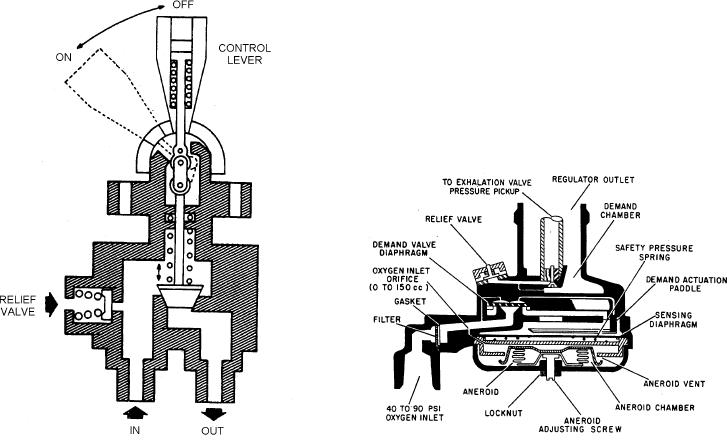
and repair of LOX lines. All low-pressure tubing used
Oxygen Shutoff Valve
in LOX systems is aluminum alloy 5052 tubing and is
The oxygen shutoff valve is installed in the system
non-heat treatable. It is manufactured in seamless,
to control the flow of oxygen to the pilot or flight crew,
round lengths, and is annealed to provide greater
as required. Figure 7-12 illustrates a typical manually
flexibility. Aircraft oxygen systems are fitted with
operated two-position valve. This valve has an inlet
5/16-, 3/8-, and 1/2-inch sizes. Low-pressure tubing
port, outlet port, and a relief port. The pressure-relief
also is installed from the pressure reducer outlets in
valve is located in the inlet chamber to protect the
reduced high-pressure oxygen systems.
oxygen regulator and crewmember from excessive
Oxygen Regulators
system pressure if there is a malfunction of the liquid
oxygen converter. Also, this valve relieves excessive
Regulators used with LOX systems are either
pressure due to thermal expansion of gaseous oxygen
console-mounted or miniature mask-mounted. The
trapped within the system when not in use. If the
miniature mask-mounted regulator was especially
oxygen system incorporates a console-mounted
designed for use with aircraft that have ejection seats.
regulator, the shutoff valve is part of the regulator.
The console-mounted regulator is normally used in
large non-ejection seat-equipped multi-place aircraft
Composite Quick-Disconnect Coupling
such as the E-6B and P-3.
The purpose of the composite quick-disconnect
MINIATURE OXYGEN BREATHING REG-
coupling is to provide a single-point connection for
ULATOR.--The miniature mask oxygen regulator,
quickly connecting and disconnecting the pilot with
shown in a cutaway view in figure 7-13, is intended
aircraft oxygen, anti-g, communications, and ventila-
primarily for use in aircraft having a low-pressure LOX
tion air services.
system and ejection seats. It is often referred to as a
miniature mask-mounted regulator. Since it weights
Oxygen Lines
only 2.3 ounces and measures approximately 2
5/8-inches in length and width, it is easily mounted on
LOX systems are classed as low-pressure systems.
the oxygen mask or user's torso harness. It is designed
As such, low-pressure tubing is used in manufacture
so that with an inlet pressure of 40 to 120 psi, it will
deliver 100-percent oxygen automatically to the user
between the altitudes of 0 and 50,000 feet.
Oxygen at system pressure, warmed to a
comfortable temperature, flows into the regulator inlet
port to the demand valve diaphragm. A small passage
from the inlet line sends this pressure to the backside of
the diaphragm; thus, the demand valve diaphragm is
Figure 7-12.--Oxygen shutoff valve.
Figure 7-13.--Cutaway view of a miniature oxygen regulator.
7-14

